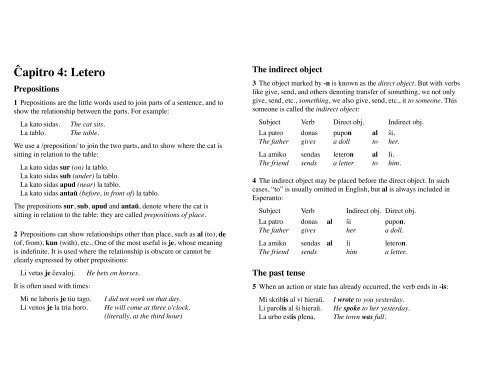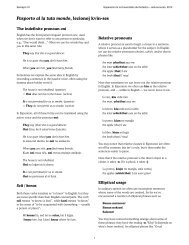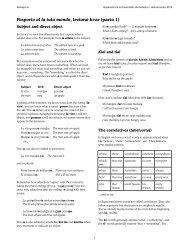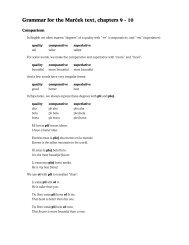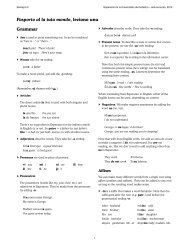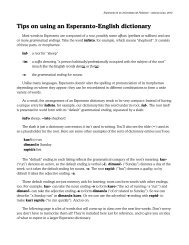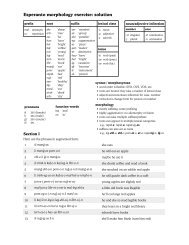The alphabet and pronunciation - Lodestone
The alphabet and pronunciation - Lodestone
The alphabet and pronunciation - Lodestone
- No tags were found...
You also want an ePaper? Increase the reach of your titles
YUMPU automatically turns print PDFs into web optimized ePapers that Google loves.
!apitro 4: LeteroPrepositions1! Prepositions are the little words used to join parts of a sentence, <strong>and</strong> toshow the relationship between the parts. For example:" La kato sidas.! <strong>The</strong> cat sits.! La tablo.! <strong>The</strong> table.We use a /preposition/ to join the two parts, <strong>and</strong> to show where the cat issitting in relation to the table:! La kato sidas sur (on) la tablo.! La kato sidas sub (under) la tablo." La kato sidas apud (near) la tablo." La kato sidas anta# (before, in front of) la tablo.<strong>The</strong> prepositions sur, sub, apud <strong>and</strong> anta#, denote where the cat issitting in relation to the table: they are called prepositions of place.2! Prepositions can show relationships other than place, such as al (to), de(of, from), kun (with), etc., One of the most useful is je, whose meaningis indefinite. It is used where the relationship is obscure or cannot beclearly expressed by other prepositions:! Li vetas je "evaloj.! He bets on horses.It is often used with times:! Mi ne laboris je tiu tago.! I did not work on that day.! Li venos je la tria horo. ! He will come at three o'clock.! ! ! ! ! (literally, at the third hour)<strong>The</strong> indirect object3" <strong>The</strong> object marked by -n is known as the direct object. But with verbslike give, send, <strong>and</strong> others denoting transfer of something, we not onlygive, send, etc., something, we also give, send, etc., it to someone. Thissomeone is called the indirect object:! Subject! Verb! Direct obj.! ! Indirect obj." La patro! donas! pupon" al" #i." <strong>The</strong> father! gives! a doll! to! her." La amiko! sendas! leteron" al" li.! <strong>The</strong> friend! sends! a letter! to! him.4" <strong>The</strong> indirect object may be placed before the direct object. In suchcases, “to” is usually omitted in English, but al is always included inEsperanto:! Subject! Verb! ! Indirect obj.! Direct obj." La patro! donas" al" #i! pupon.! <strong>The</strong> father! gives! ! her! a doll." La amiko! sendas" al" li! leteron.! <strong>The</strong> friend! sends! ! him! a letter.<strong>The</strong> past tense5" When an action or state has already occurred, the verb ends in -is:! Mi skribis al vi hiera$.! I wrote to you yesterday.! Li parolis al #i hiera$.! He spoke to her yesterday.! La urbo estis plena.! <strong>The</strong> town was full.


